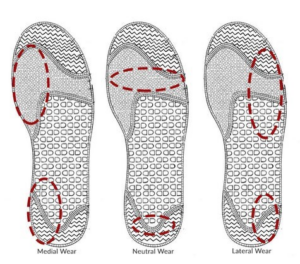Written by Vanessa Mahoney, MBA, BS, LAT, ATC, Associate Manager, Athletic Trainer
Have you ever wanted to get into running? A key starting point is selecting the right sneakers. Picking the proper running sneakers for your foot structure that supports your weight distribution while you are running is crucial for performance. A proper running sneaker can help you log more miles and prevent injuries, ultimately helping you reach your optimum performance goals. Finding the correct sneakers is as easy as looking at the soles of your current shoes!
As you examine the bottom of your shoes, you should be able to identify one of the three common running patterns:
- If you have a medial wear pattern on the bottom of your running sneakers, it is typically caused by overpronation. Overpronation occurs when your foot’s natural inward cushioning roll is exaggerated. This can lead to foot, ankle, knee, and hip-related running injuries. It can also lead to arch collapse, plantar fasciitis, and inefficiency in training to run. One who tends to overpronate would benefit from wearing motion control sneakers, which will help guide the foot and correct weight transfer.
- If you have a neutral wear pattern on the bottom of your running sneakers, it will present itself as even abrasion throughout the ball and forefoot area of the outsole. Weight is transferred throughout the foot with a biomechanical pronation, the body’s natural way of absorbing shock while running. One who identifies a neutral wear pattern would benefit from stability sneakers. These sneakers offer slight medial (inner side) support, along with a stable mid-sole cushion.
- If you have a lateral wear pattern on the bottom of your running sneakers, the wear will be present on the outer, lateral edge of your running shoe. This pattern is typically caused by underpronating or supinating, when the weight is primarily transferred onto the outer edge of the foot. This can lead to stress-related bone and joint injuries in the lower extremity. Underpronators do not have the body’s natural shock absorbing motion and need additional cushioning on their shoes. One who finds themself with this running pattern can benefit from cushioning sneakers as they assist in displacing the impact on the feet during running. Underpronating is rate, and only observed in about 5% of the running population.

Understanding the importance of the wear and tear of your sneakers can help in many ways. Choosing the proper running sneakers can help prevent injuries associated with your running style that you may not recognize you are prone to, as well as leading to improved performance overall. Take the time to analyze the bottom of your shoes, it will be worth it!
Citation:
Paige, Mark “What Your Running Shoes Wear Patterns Mean” Tread Labs https://treadlabs.com/blogs/insoles-reach-your-stride/34786373-what-are-your-running-shoes-trying-to-tell-you
